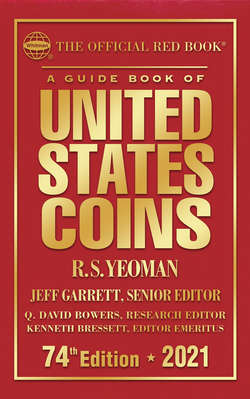Читать книгу A Guide Book of United States Coins 2021 - R.S. Yeoman - Страница 23
На сайте Литреса книга снята с продажи.
Excitement of a New Design
ОглавлениеIn the panorama of American coinage, some new designs have captured the fancy of the public, who saved them in large quantities when they were released. In many other instances new designs were ignored, and coins slipped into circulation unnoticed.
In 1909, much publicity was given to the new Lincoln portrait to be used on the one-cent piece, replacing the familiar Indian Head motif. On the reverse in tiny letters were the initials, V.D.B., of the coin’s designer, Victor David Brenner. The occasion was the 100th anniversary of Lincoln’s birth. Coinage commenced at the Philadelphia and San Francisco mints. In total, 27,995,000 1909 V.D.B. cents were struck and 484,000 of the 1909-S V.D.B.
On August 2, 1909, the new cents were released to the public. A mad scramble ensued, and banks had to ration the number paid out to any individual, particularly in the East. Interest in the West was less intense, and fewer coins were saved. A controversy arose as to the V.D.B. initials, and some newspaper notices complained that as Brenner had been paid for his work, there was no point in giving his initials a prominent place on the coins. Never mind that artists’ initials had been used on other coins for a long time. As examples, the M initial of George T. Morgan appeared on both the obverse and reverse of silver dollars from 1878 onward; Chief Engraver Charles E. Barber was memorialized by a B on the neck of Miss Liberty on dimes, quarters, and half dollars from 1892 onward; and the recent (1907 onward) double eagles bore the monogram of Augustus Saint-Gaudens prominently on the obverse. In spite of these precedents, the offending V.D.B. initials were removed, and later 1909 and 1909-S cents were made without them.
Word spread that the cents with V.D.B. would be rare, and even more were saved. Today, the 1909 V.D.B. cents are readily available in Mint State. The 1909-S V.D.B., of lower mintage and of which far fewer were saved, lists for $1,350 in MS-63.
A few years later, at the Denver Mint, 1,193,000 1914-D cents were struck. Not much attention was paid to them, and today examples are rare, with an MS-63 listing for $3,000. Years later, only 866,000 1931-S cents were made. However, at this time there was a strong and growing interest in the numismatic hobby, and the low mintage figure was widely publicized; and although the mintage of the 1931-S is lower than for the 1914-D, an MS-63 1931-S is valued at just $195.
